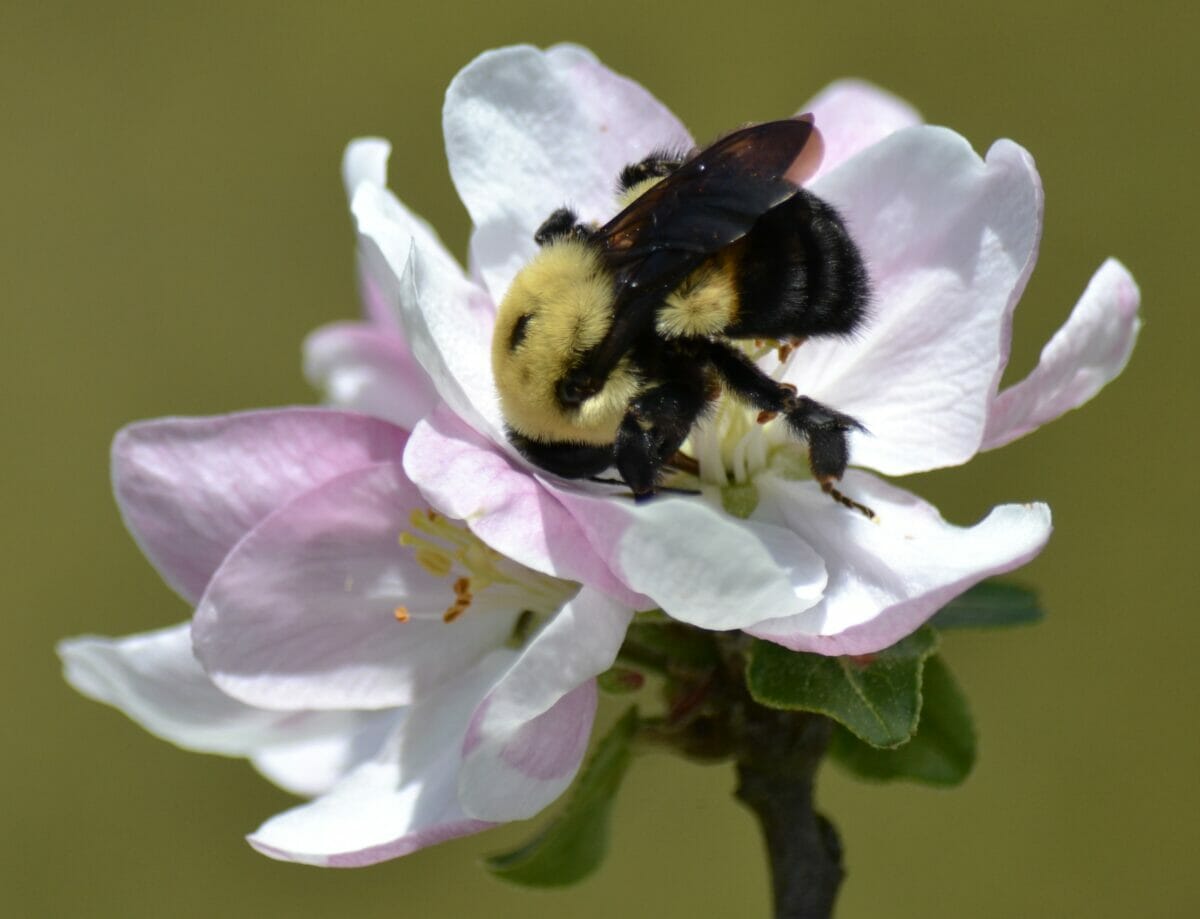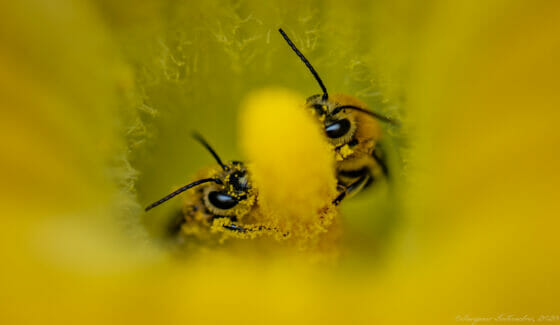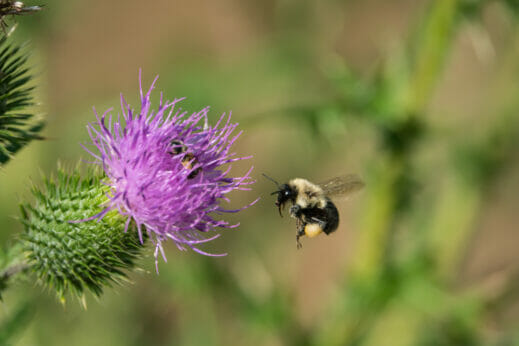Public awareness of the plight of the European honey bee overlooks thousands of native bees and their contributions to pollination.

Dr. Jim Cane is out in the squash fields before the sun peeks out over the eastern horizon. He knows that if he starts early, he can find male squash bees sleeping within the collapsed husks of yesterday’s squash flowers. Cane is a research entomologist. He’s spent much of his career as a bee specialist with the US Department of Agriculture’s Agricultural Research Service and he’s an authority on the agricultural benefits of many of the 3,600 diverse species of wild, native bees, including squash bees.
Male squash bees are ready at first light to greet females as they emerge from their shallow nests in the soil and start the day’s work of pollinating plants in the squash family: cucumbers, pumpkins and melons. Squash bees are working hard for hours before honey bees may join them in the fields. And squash bees are well adapted to pollinating their preferred plants.
“Squash flowers produce large, spiny, starchy pollen grains,” says Cane. “Honey bees actively rub and discard the sticky squash pollen off their bodies. Frequently, squash is blooming when corn is tasseling and, as honey bees prefer corn pollen, they tend to spend their time with the corn. But squash bees aren’t distracted by other plants: They’re reliable squash pollinators.”
Honey bees arrived in North America in the 17th century, carried by European colonists. They’re actively managed in hives and are considered domestic livestock. Where I live in North Carolina, growers with large cucumber and squash farms rent honey bees at a cost of $100 or more per hive and require 1-2 hives per acre during each season. But why would a farmer hire expensive pollination services when the squash bees work for free?
For years, the advice farmers received was similar to that given in this North Carolina extension apiculturalist bulletin: “Only honey bees are available in adequate numbers to ensure good cucumber fruit set.” Lately, though, the state has tried to increase awareness about the capabilities of wild, native bees to pollinate North Carolina’s crops. Cane told me that for pollinating crops such as squashes, gourds and pumpkins, “It’s clear that native bees are the best.” Others who study squash pollination concur. But many farmers are not aware of native bees. Native bees don’t always resemble honey bees and vary in size, so farmers may not know if they have other pollination options nearby.

Squash bees in a pumpkin flower. (Photo: Jacques M. LeTendre)
Save The Honey Bee! North Carolina has an option to buy a specialty license plate to publicize the plight of the honey bee. Federal dollars, through the US Department of Agriculture, support beekeepers with insurance, disaster assistance, diagnostic testing, loans and grants. But are honey bees in danger or are we misdirecting our resources towards the wrong bee?
I’m a veterinarian with a honey bee-exclusive practice and I see the challenges my clients face to keep their colonies alive. It’s not just a local phenomenon. Recently, the Bee Informed Partnership reported that an estimated 50 percent of honey bee colonies died between the summers of 2022 and 2023, as reported by those beekeepers across the mainland US who completed the Bee Informed Partnership’s annual survey.
While those annual losses may seem extreme, beekeepers can create new colonies by buying new queens through the mail, by splitting vigorous hives ready to swarm and by moving bees among hives to strengthen and save weak colonies. With intensive management, honey bee colony numbers have remained relatively stable in the US over the last few decades and have even been observed to rise periodically with the price of honey.
Successful beekeeping requires attention and a regular time commitment for colony management, feeding and parasite control. And for those new to the craft and science of beekeeping, some find themselves unable to keep their hives going over the years. Is there an alternative to the expense or time investment in honey bee pollination for a farmer growing pollinator-dependent crops?
It’s clear that crop yields are higher with better pollination. Wild, native bees served the plants and crops of North America for millennia and are still the foundation of pollination services in all but the largest farms today. Depending on the size of the operation and the nature of land use on and around the farm, people may have the option of relying upon native bees for pollination.
Many farms already benefit from wild, native bee pollination. Cranberry yields are higher when native bees are at work. The southeastern blueberry bee is the most efficient pollinator of blueberries in the southern United States. Native bee pollinators are reported to produce larger strawberries than honey bees. But native bee abundance is heavily influenced by the availability of adequate habitat such as areas of undisturbed ground, as most native bees nest in the ground. They need space where pesticide use is low enough that they can successfully reproduce and become (or remain) locally established.

A bumblebee visits a thistle flower. (Photo: Shutterstock)
How does one determine if there are existing native bees on a farm? It can be a challenge for busy people to learn how to recognize them. People can start to identify native bees by observing the weather conditions and time of day. Honey bees favor the warmest hours midday, while native bees start their work earlier. Native bees may be more likely to be observed working alone during breezy, cooler days and days with light rain.
With support and monitoring, it may be possible to downsize the number of honey bee pollinators over time until native populations are sufficient for a farms’ pollination needs. By augmenting existing flowering plants and space for bee habitat, more native bees can be attracted into an area.
All bees are enduring unprecedented challenges: extreme weather, pests and disease, habitat and flower losses and potent, water-soluble insecticides that contaminate plants, soil and water far from where they’re applied. Regardless of how farm pollination is managed, a diversity of native flowering plants that bloom over the entire growing season supports pollinators and other beneficial insects that will aid in crop pest control. Large perennial plantings among crop areas provide sections of undisturbed soil and are ideal to maximize the numbers of native pollinators who will survive and become established on site.
Where native bees are abundant and present, it’s easy to overlook their contributions. I’ve seen this in my own fruit orchard. I took my high pollination rates for granted and resented the chore of thinning fruit during late spring each year. When my native pollinators disappeared due to local contamination, I was shocked during the springs that followed to see fruit trees flower yet remain barren.
Cane, the research entomologist, told me a similar story on a much larger scale. He’d been working with a student among pumpkin growers in the Texas Panhandle who enjoyed high yields each year from their local squash bees. “One year, they allowed aerial spraying of insecticide on their blooming fields and after that complained of poor crop yields. The once plentiful squash bees were gone,” he says.
Depending upon where a farm is located and the specific pollination needs, a farmer may be able to partner with the native pollinators that already inhabit the area. If honey production is a goal or if supplemental honey bee pollination is needed, pesticide-free native flowering plants, trees and shrubs will support both honey bees and wild, native insect pollinators of all stripes.
Elizabeth D. Hilborn, DVM is a honey bee specialist veterinarian and author of: Restoring Eden: Unearthing the Agribusiness Secret That Poisoned My Farming Community.
As a flower farmer I rise each day before the sun, and at daybreak I’m gingerly brushing past native bumblebees sleeping atop the wide, pillowy blooms of the zinnias. Soon they’re awake and they spend the day with me, rain or shine, diligently working sun up to sun down. They sneak into the snapdragon blossoms just as I’m about to harvest a stem, roll around with jubilation in the pollen of peonies, and dance about the spiky tops of echinacea, their corbiculae glowing with yellow pollen. It saddens me to read about the pumpkin farmers who weren’t aware that broad… Read more »
Excellent article. Will need to work more on helping native bees.
Dancing with Bees is an excellent book supporting the protection of all bees.
